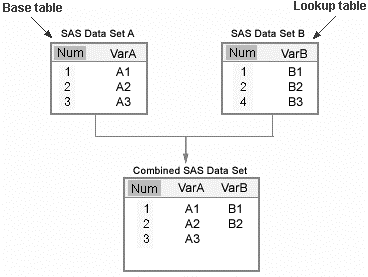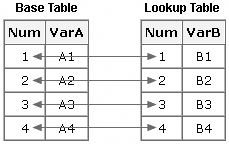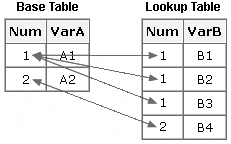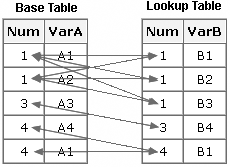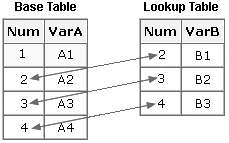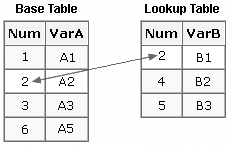Reviewing Terminology
Overview
Before you examine the various techniques for combining
data horizontally, here is a review of some of the terminology that
this chapter uses.
|
Term
|
Definition
|
|---|---|
|
combining data horizontally
|
A technique in which
data is retrieved from an auxiliary source or sources, based on the
values of variables in the primary source.
|
|
performing a table lookup
|
A technique in which
data is retrieved from an auxiliary source or sources, based on the
values of variables in the primary source.
|
|
base table
|
The primary source in
a horizontal combination. In this chapter, the base table is always
a SAS data set.
|
|
lookup table or tables
|
Any input data source,
except the base table, that is used in a horizontal combination.
|
|
lookup values or return
value
|
The data value or values
that are retrieved from the lookup table or tables during a horizontal
combination.
|
|
key variable or variables
|
One or more variables
that reside in both the base table and the lookup table. Usually,
key values are unique in the lookup table but are not necessarily
unique in the base table.
|
|
key value or values
|
A lookup is successful
when the key value in the base table finds a matching key value in
the lookup table.
|
Note: The terms combining
data horizontally and performing
a table lookup are synonymous and are used interchangeably
throughout this chapter.
Note: This chapter compares PROC
SQL techniques with DATA step techniques. In PROC SQL terms, a SAS
data set is usually referred to as a table,
a variable is usually referred
to as a column, and an observation is
usually referred to as a row.
The following figure
illustrates a base table and a lookup table that are used in a horizontal
combination. The key variable is Num. The key values are listed vertically
below Num.
Relationships between Input Data Sources
One important
factor to consider when you perform a table lookup is the relationship
between the input data sources. In order to combine data horizontally,
you must be able to match observations from each input data source.
For example, there might be one or more variables that are common
to each input data source. The relationship between input data sources
describes how the observations in one source relate to the observations
in the other source according to these key values.
The following terms
describe the possible relationships between base tables and lookup
tables:
-
one-to-one match
-
one-to-many match
-
many-to-many match
-
nonmatching data
In a one-to-one
match, key values in both the base table and the lookup table are
unique. Therefore, for each observation in the base table, no more
than one observation in the lookup table has a matching key value.
In a
one-to-many match, key values in the base table are unique, but key
values in the lookup table are not unique. That is, for each observation
in the base table, there can be one observation or possibly multiple
observations in the lookup table that have a matching key value.
In a
many-to-many match, key values are not unique in the base table or
in the lookup table. That is, at least one observation in the base
table matches multiple observations in the lookup table, and at least
one observation in the lookup table matches multiple observations
in the base table.
Many-to-many is a theoretical
or mathematical possibility, but it rarely represents a legitimate
business application. If a business application appears to be many-to-many,
it is usually because a duplicate row was accidentally added to the
lookup table.
Sometimes
you will have a one-to-one, a one-to-many, or a many-to-many match
that also includes nonmatching data. That is, there are observations
in the base table that do not match any observations in the lookup
table, or there are observations in the lookup table that do not have
matching observations in the base table. If your base table or lookup
table or tables include nonmatching data, you will have one of the
following:
..................Content has been hidden....................
You can't read the all page of ebook, please click here login for view all page.

